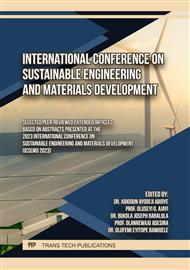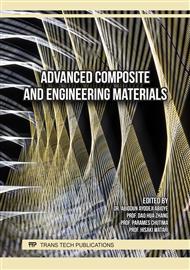[1]
Asare M. O, Száková J and Tlustoš, P (2023), Mechanisms of As, Cd, Pb, and Zn hyperaccumulation by plants and their effects on soil microbiome in the rhizosphere. Front. Environ. Sci. 11:1157415
DOI: 10.3389/fenvs.2023.1157415
Google Scholar
[2]
Moses, S; Agbaji, E.B; Ajibola, V.O; and Gimba, C. E (2018).Heavy Metals Content in Water and Crops in Golding Mining Vicinity on Major Dams in Zamfara State, Nigeria. J. Appl. Sci. Environ. Manage. 22 (6) 973 –979
DOI: 10.4314/jasem.v22i6.22
Google Scholar
[3]
Bernard, E. and Ayandeji, O.M (2020). Impact of industrial effluents, domestic wastewater and natural dams on heavy metals concentrations in vegetables cultivated in Northern Nigeria. 12(1), 1-7
DOI: 10.5897/JECE2019.0451
Google Scholar
[4]
Ahmadzadeh, S and Dolatabadi, M. (2018) Modeling and kinetics study of electrochemical peroxidation process for mineralization of bisphenol A; a new paradigm for groundwater treatment. Journal of Molecular Liquids 254, 76–82
DOI: 10.1016/j.molliq.2018.01.080
Google Scholar
[5]
Al-Raad, A., Hanafiah, M. M., Naje, A. S., Ajee, M. A., O. Basheer, A., Ali Aljayashi, T., and Ekhwan Toriman, M. (2019). Treatment of Saline Water Using Electrocoagulation with Combined Electrical Connection of Electrodes. Processes, 7(5), 242
DOI: 10.3390/pr7050242
Google Scholar
[6]
Andreozzi, M., Álvarez, M. G., Contreras, S., Medina, F., Clarizia, L., Vitiello, G., and Marotta, R. (2018). Treatment of saline produced water through photocatalysis using rGO-TiO 2 nanocomposites. Catalysis Today, 315, 194–204.
DOI: 10.1016/j.cattod.2018.04.048
Google Scholar
[7]
Dehghani, M. H. Dehghan, A. Alidadi, H. Dolatabadi, M. Mehrabpour, M and Converti A. Removal of methylene blue dye from aqueous solutions by a new chitosan/zeolite composite from shrimp waste: kinetic and equilibrium study, Korean J. Chem. Eng. (2017).1–9.
DOI: 10.1007/s11814-017-0077-2
Google Scholar
[8]
Gilhotra, V., Das, L., Sharma, A., Kang, T.S., Singh, P., Dhuria, R.S., and Bhatti, M.S., Electrocoagulation technology for high strength arsenic wastewater: process optimization and mechanistic study. J. Cleaner Prod. 198, (2018), 693–703.
DOI: 10.1016/j.jclepro.2018.07.023
Google Scholar
[9]
Hashim, K.S., Al Khaddar, R., Jasim, N., Shaw, A., Phipps, D., Kot, P., Pedrola, M.O., Alattabi, A.W., Abdulredha, M., and Alawsh, R., Electrocoagulation as a green technology for phosphate removal from River water. Sep. Purif. Technol. 210, (2019), 135–144.
DOI: 10.1016/j.seppur.2018.07.056
Google Scholar
[10]
Hashim, K.S., AlKhaddar, R., Shaw, A., Kot, P., Al-Jumeily, D., Alwash, R., and Aljefery, M. H., Electrocoagulation as an eco-friendly River water treatment method. In: Advances in Water Resources Engineering and Management. Springer, (2020). 219–235.
DOI: 10.1007/978-981-13-8181-2_17
Google Scholar
[11]
Islam, S.D.-U., Electrocoagulation (EC) technology for wastewater treatment and pollutants removal. Sustain. Water Resources. Management. 5, (2019), 359–380.
DOI: 10.1007/s40899-017-0152-1
Google Scholar
[12]
Kamaraj, R. Pandiarajan, A. Gandhi, M.R. Shibayama, A. and Vasudevan, S. (2017) Eco friendly and easily prepared graphene nanosheets for safe drinking water: removal of chlorophenoxyacetic acid herbicides, Chem. Sel. 2, 342–355.
DOI: 10.1002/slct.201601645
Google Scholar
[13]
Khan, M. and Lo, I.M. (2017). Removal of ionizable aromatic pollutants from contaminated water using nano γ-Fe2 O3 based magnetic cationic hydrogel: sorptive performance, magnetic separation and reusability, J. Hazard. Mater. 322,195–204
DOI: 10.1016/j.jhazmat.2016.01.051
Google Scholar
[14]
McBeath, S.T., Mohseni, M., and Wilkinson, D.P., (2018). Pilot-scale iron electrocoagulation treatment for natural organic matter removal. Environ. Technol. 1–9.
DOI: 10.1080/09593330.2018.1505965
Google Scholar
[15]
Oke, I. A; Adie D.B; Ismail A.; Lukman, S; Igboro S.B and Sanni, M.I. (2014) Computer Simulation In The Development And Optimization Of Carbon Resin Electrodes For Water And Wastewater Treatment Electrochemically. Ife Journal of Science. 16,(2), 227- 239
Google Scholar
[16]
Oke, I. A, 0bijole, O. A; Adekunbi, E. A, Babajide, J. O; ldi, M-D. and Aladesanmi, O. T. (2021). Thermal Property of Carbon Resin Electrodes Developed for Electrochemical Treatment of Water and Wastewaters. FUTAJEET, 15(1), (2021). 84-91. https://doi.org/10.514591futajeet.2021.15.1.157
DOI: 10.51459/futajeet.2021.15.1.157
Google Scholar
[17]
Lee, D., Kondo, A., Lee, S., Myeong, S., Sun, S., Hwang, I., and Paik, U. (2020). Controlled swelling behavior and stable cycling of silicon/graphite granular composite for high energy density in lithium-ion batteries. Journal of Power Sources, 457, 228021
DOI: 10.1016/j.jpowsour.2020.228021
Google Scholar
[18]
Li, Y., Wei, C., Sheng, Y., Jiao, F., and Wu, K. (2020). Swelling Force in Lithium-Ion Power Batteries. Industrial & Engineering Chemistry Research
DOI: 10.1021/acs.iecr.0c01035
Google Scholar
[19]
Lu, D., Lin, S., Cui, W., Hu, S., Zhang, Z., and Peng, W. (2020). Swelling mechanism of 0%SOC lithium iron phosphate battery at high temperature storage. Journal of Energy Storage, 32, 101791
DOI: 10.1016/j.est.2020.101791
Google Scholar
[20]
Park, K., Myeong, S., Shin, D., Cho, C.-W., Kim, S. C., and Song, T. (2018). Improved swelling behavior of Li ion batteries by microstructural engineering of anode. Journal of Industrial and Engineering Chemistry
DOI: 10.1016/j.jiec.2018.11.035
Google Scholar
[21]
Oke, I.A (2009) Influence Of Carbonization On Selected Engineering Properties Of Carbon Resin Electrodes For Electrochemical Treatment Of Wastewater. Canadian Journal of Chemical Engineering, 87 (10), 801 – 811
DOI: 10.1002/cjce.20218
Google Scholar
[22]
APHA, (2015) Standard Method for the Examination of Water and Wastewater, 23rd edn, America Water Works Association and Water Pollution Control Federation, Washington DC.
Google Scholar
[23]
Mark, van Loosdrecht, M.C.M., Nielsen, P.H. Lopez- Vazquez, C.M., Brdjanovic, D.,(2016) Experimental Methods in Wastewater Treatment. 1st Edition, International Water Publishing Alliance House, London.
DOI: 10.2166/9781780404752
Google Scholar
[24]
Pobočíková, I.; Sedliačková, Z. and Michalková, M (2017). Application of four probability distributions for wind speed modelling. TRANSCOM 2017: International scientific conference on sustainable, modern and safe transport. Procedia Engineering 192 (2017) 713 – 718
DOI: 10.1016/j.proeng.2017.06.123
Google Scholar
[25]
Jones, L. D.; Vandeperrea, L.J. Haynes, T.A. and Wenman, M. R. (2020). Theory and application of Weibull distributions to 1D peridynamics for brittle solids. Comput. Methods Appl. Mech. Engrg. 363, 112903
DOI: 10.1016/j.cma.2020.112903
Google Scholar
[26]
Faruk Oral, Ismail Ekmekçi and Nevzat Onat Weibull distribution for determination of wind analysis and energy production. World Journal of Engineering 12(3) (2015) 215-220
DOI: 10.1260/1708-5284.12.3.215
Google Scholar
[27]
Ferhat Bingo¨ Comparison of Weibull Estimation Methods for Diverse Winds. Volume 2020, Article ID 3638423, 11 pages
DOI: 10.1155/2020/3638423
Google Scholar
[28]
Fan Yang, Hu Ren, and Zhili Hu. Maximum Likelihood Estimation for Three-Parameter Weibull Distribution Using Evolutionary Strategy. Volume 2019, Article ID 6281781, 8 pages
DOI: 10.1155/2019/6281781
Google Scholar
[29]
Kumar, M., Singh, S. K., Singh, U., and Pathak, A. (2019). Empirical Bayes estimator of parameter, reliability and hazard rate for Kumaraswamy distribution. Life Cycle Reliability and Safety Engineering
DOI: 10.1007/s41872-019-00085-0
Google Scholar
[30]
Arora, S., Mahajan, K. K., and Kumari, R. (2019). Bayes estimators for the reliability and hazard rate functions of Topp-Leone distribution using Type-II censored data. Communications in Statistics-Simulation and Computation, 1–18
DOI: 10.1080/03610918.2019.1602646
Google Scholar



